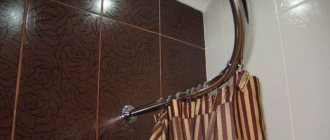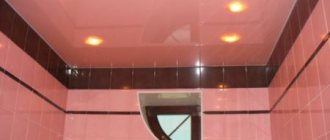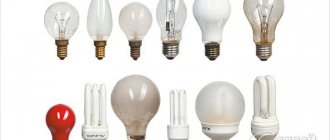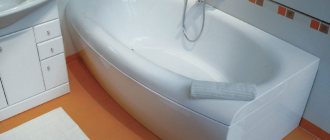Modern heated towel rails sometimes look like objects of avant-garde art. Their whimsical shapes involuntarily attract the eye, making a utilitarian item an exquisite accessory. But there is no and probably will not be a dryer more reliable, simpler and more versatile than the “snake”, well known from childhood. If you plan to replace or install a heated towel rail, you should choose a regular coil made from domestically produced seamless pipes for the bathroom. This design perfectly withstands pressure in the system; its installation does not require re-equipment of the wiring. And modern models made of shiny or enamel pipes can be quite attractive.
Functionality. Application
Coil
The relevance and prevalence of the coil has increased quite recently and has rapidly captured the domestic market of plumbing fixtures. The remarkable efficiency of the heating element is justified by its compactness and heating efficiency. Bulky, heavy radiators are extremely impractical in a small bathroom. The following functional features of the coils ensure the popularity of the device.
The relevance of coils is justified by the increased humidity, which, in turn, provokes the development of mold. Modern lines of snake-like dryers have acquired new forms: ladder, drop.
Design features of modern coils
Modern heated towel rails have long evolved from a standard painted coil into an original design object . Such products have become so widely popular that when developing their appearance, famous designers are involved, who create original products, which are later replicated and put on store shelves. Such an original device not only copes with its direct responsibilities, but also decorates any bathroom.
On the plumbing equipment market, every homeowner will be able to choose a suitable product in a color that matches the overall design of the bathroom. This will complement the overall styling of the interior, making it complete and organic. By choosing products in bright colors, you can play on the contrast of the bathroom, emphasizing its individuality. If bright shades do not attract the homeowner, then you can always choose a chrome product that will succinctly fit into a room designed in a minimalist or high-tech style.
Counteracting biological organisms
Conditions of high humidity inevitably provoke the formation of condensation, which, in turn, becomes an ideal environment for the development of fungi and mold. If you ignore the recommendations of specialists and do not clean the wall covering from condensation in a timely manner, a destructive effect is inevitable. Deformed walls, mold formation and the risk of infectious development. In addition, in damp conditions, a snake-like heater is an indispensable device in the bathroom.
Purpose of a bathroom coil
A wall-mounted bathroom dryer designed in the form of a coil performs several functions:
- Dries towels, washed linen, wet clothes, shoes, acting as a battery.
- It warms the room, maintaining constant heat and increasing the comfort of its use after taking water procedures in the bath or shower. When going out into the open air, a wet body will not experience discomfort when it comes into contact with too cold air.
- Dries moisture, leveling the steam effect and protecting the room from the formation of fungus and mold, preventing corrosion of metal parts of plumbing fixtures, household appliances, elements of sockets, switches and lighting.
Double-circuit heated towel rails
Distribution of coils: types
The domestic and foreign market is filled with a sufficient number of heating coils. The main types of devices are:
- Water type heating. Coils mainly work in the cold season, as they are integrated into the central heating system.
- Electric type. The coil filler is oil or water. The advantage of the heater remains the ability to activate heating at any time.
- Combined type. Includes integration into the central heating system, as well as equipping with a fuel element. Of course, you can use it in the cold season.
Note: the cost of combined heated towel rails is significantly higher.
Before purchasing a coil, it is recommended that you familiarize yourself with the key features of your choice:
- During operation, it is necessary to pay attention to the pressure indicator in the central heating system. Otherwise, there is a danger of destruction of the coil structure with further failure.
- A special instruction table is supplied with any coil, which contains recommended heat output values.
Water coil
Water coil
The most common coil heater relevant on the market remains the water type. This is justified, first of all, by the market value of the device. The coil is directly connected to the central heating system, which means that during the warmer months the heater will not operate. It is noteworthy that the presence of autonomous heating in the house will allow you to judiciously use the heating capabilities of the apartment. The coil is heated by intensive circulation of hot water in the pipes.
However, a negative point in the operation of water coils remains the risk of pipe clogging. The most common root causes of this are:
- Water quality. Low-quality water in the heating system inevitably leads to clogged pipes.
- Presence of scale. In this case, third-party objects lead to disruption of water circulation.
- Air. So-called air locks require regular cleaning of the coil. It is noteworthy that for this it is better to use the services of a specialist.
Note: the durability of the coils is quite indicative: the average service life of a coil heater is from 7 to 8 years.
An additional and significant problem in the operation of a water-type coil will be the danger of complete clogging, which requires a comprehensive replacement of the coil.
Electric coil
Electric coil
The classic heating option in a modern bathroom remains the electric coil. The advantageous aspect of this type of coil remains autonomy in operation and practicality in installation. So, regardless of the location of the heating communication, only a socket is required for the operation of an electrical appliance. Water or high-quality oil is used as filler for the electric coil. After activating the device, the coil will reach the desired temperature in a short time.
It is noteworthy that the amount of electricity consumed does not exceed 100 W per month. Consequently, complex heating of a bathroom will cost a month of using a regular 100 W lighting lamp.
However, before purchasing a device, be sure to study the indicated power, as well as the presence of a temperature control toggle switch. It is better to entrust the installation of the coil to a professional, since the bathroom is an environment of high humidity, where the conductivity of electricity is slightly increased.
Combined coil
The prerogative of this type of heater remains the possibility of universal use of the coil both in summer and during the heating season. In this way, the accumulation of excess moisture during the transition period can be avoided.
The ergonomics of the coil are obvious - energy savings during the heating season. However, the market value of the heater significantly exceeds the cost of analogues. In addition, the installation process requires the intervention of a specialist due to the fact that the coil needs to be connected to the central heating system. Also, you need to make sure that there is an additional power source - an outlet.
The correct location of the heater is fraught with practicality and ease of use.
Why domestic heated towel rails are more reliable than imported ones
Imported equipment is most often designed to be connected to a heating system. In addition to being inconvenient, the quality of water in our heating networks leaves much to be desired, so pipes and dryer seals fail very quickly.
Another detail is that the thread diameter in domestic devices almost always coincides with the connecting nodes on the pipeline. On imported coils these parameters may not be the same. But this is not the most important thing.
The pressure in the hot water system depends on the condition of the pipeline, the initial pressure in the boiler room and even the number of floors. According to standards, the pressure at the entrance to plumbing equipment should not exceed 4.5 atmospheres, but in practice this value can be much higher, especially on the lower floors.
The design pressure for coils is 6 atm. in operating mode and 10 atm. during overloads. In practice, it is advisable to choose values an order of magnitude higher; this will provide some guarantee against a gust during a strong pressure surge.
Important! Domestic heated towel rails are designed for large pressure surges. Imported structures may not withstand peak overloads.
Features of choice. Device material
Stainless steel coil
The features of the heating process are quite similar, although the material of the coils is significantly different.
The domestic market is filled with heaters consisting of the following materials:
- Stainless steel. The most versatile, durable and practical option. However, stainless steel is extremely labile to low-quality heating water. High-quality coils are predominantly coated with durable paint materials such as chrome, waterproof compounds and polish. By the way, painted coils are cheaper, however, the paint coating quickly becomes unusable.
- Dark steel. The so-called black steel is in most cases covered with an additional protective layer. The inner walls of the coil contain a comprehensive anti-corrosion coating, which prevents early malfunction of the device.
- Non-ferrous materials – metals. The prerogative in this type of materials is brass and copper, which are characterized by a high degree of heat transfer. However, a limited service life negatively affects the popularity of the product on the market. Coils on non-ferrous metal are characterized by aesthetic beauty.
Note: Do not under any circumstances purchase a coil that is low in cost. Most likely, the heater uses fake or low-quality stainless steel.
Materials for making a coil
Regardless of the operating principle of different heated towel rails, the following common materials are used for their manufacture:
- The stainless steel variety is considered a practical choice for a heated towel rail in the bathroom. However, it must be taken into account that due to the aggressive composition and impurities in the coolant, they gradually destroy even such a durable material. Chrome-plated coils are considered the most reliable and visually attractive.
- Ordinary steel coated with a protective layer. A special feature of this heated towel rail is that the inside of the coil pipes is coated with a special anti-corrosion layer. At the same time, such a product is no different in appearance from its stainless steel counterpart.
- More expensive models of bath coils are made of copper or brass, which have a high degree of heat transfer. However, the cost of such products is very high. When buying such a device, you need to be extremely careful, since due to the high cost of the material used in its manufacture, you can often stumble upon a fake.
Regardless of what kind of coil you will purchase for a bathtub in an apartment or private house, it is better to give preference to well-known manufacturers who are concerned about their reputation and consumer safety.
Acquisition relevance pledge
When choosing a quality coil, pay attention to the following parameters:
- Features of the bathroom. It is worth considering the fact of accessibility and proximity of heating communications, as well as a source of electricity.
- Heating coil material. Rely on the material's anti-corrosion properties as well as its durable ability to resist chemical additives in your heating water.
- The size of the heating coil plays a priority role in the installation process. An oversized device will most likely place additional stress on the wall covering. In addition, the diameter of the central heating system pipes should be taken into account.
- Bathroom style. The domestic market contains a huge number of different coils, differing in color, material and design features.
- Availability of technical documentation. Be sure to request the coil's passport.
Choosing a high-quality and efficient heating coil will provide your bathroom with a comfortable air temperature.
Tips for choosing a coil
When purchasing a heated towel rail for a bathroom, consider the following factors:
- For typical bathrooms in communal multi-storey buildings, small or small-sized coils are purchased - a large-sized device will overheat the room, reducing the comfort of water procedures and washing clothes.
- In large rooms with showers or bathtubs, coils with a high surface area are installed - M-C-shaped or multi-section E-shaped, ladder-type heated towel rails.
- For individual houses, it makes sense to purchase a combined coil-towel rail with an electrical connection - this will allow you to maintain a comfortable temperature in the room in the absence of hot water.
- To improve heat transfer in large areas, it is better to install products made of chrome-plated brass, which have high thermal conductivity.
Options for connecting coils with taps and bypass
Current rules for installing a coil
If you install the heating coil yourself, make sure you have the following set of tools:
- A powerful hammer drill or a modern impact drill.
- Screwdriver.
- Fastening elements.
- Construction ruler and level for measuring indicators.
To connect the central heating system and the coil you will need a high-quality coupling. However, the negative aspect of using a classic coupling is the impossibility of quick dismantling. Purchasing “American women” will allow you to instantly install or remove the connecting element.
Electric heating coils remain the simplest and most practical to install, requiring only installation and direct connection to the electrical network. It is noteworthy that if you are replacing a pre-existing coil, you can use the old fasteners. As a source of electricity, it is worth taking care to completely protect the outlet from moisture. The bathroom is an environment of high electrical conductivity.
Combined coil designs
Such a universal device has absorbed all the positive characteristics of both water and electric coils. However, despite the functionality of such a product and the possibility of its use regardless of central heating, it has a rather high cost. Although such costs are justified , since there is no need to be afraid of interruptions in the supply of electricity or heat supply - in the absence of one of the coolants, there is always another heat source available.
Installing a coil - video
A significant problem when installing combined or water coils remains the need for connection to the heating system. However, the pressure indicator should be taken into account, since a change in pressure can cause damage to the coil from the inside. Pay attention to the connection parameters used in the coils:
- 19 millimeters. Used in a modern type heater - staircase.
- 25 millimeters. Coils P, M-like shape.
- 32 millimeters. The most common diameter of coil pipes.
- 40 millimeters. Used in arc heaters and foxtrots.
The coil installation process is as follows:
- Blocking the central water pipe. Removing the old coil, if present.
- Carefully assemble the structure using the included instructions.
- The coil is leaned against the wall covering, and the spot locations for installing fasteners are marked.
- Using a hammer drill, holes are made in the designated areas. Screwdrivers are installed in the required places.
- The final stage is the most difficult. So, it is necessary to install connecting pipes, as well as make taps, if required. One way or another, the installation process requires the assistance of a qualified specialist.
Note: installation of a combined type heating coil requires an additional electrical connection.
A heating coil is a versatile and practical way to provide your bathroom with the right degree of comfort and genuine convenience.
Connection
Different types of devices require different installation conditions. There are options that are quite easy to connect, and there are those that require some fiddling.
Mermen
There are several options here:
- Side – allows you to install the device anywhere in the bathroom and at the same time effectively distribute the heat.
- Bottom - the coolant enters the lower hole, passes throughout the entire coil and leaves through the opposite pipe. Since the cooling portion is constantly being replaced by a “fresh” one, heating occurs effectively, but only if there is sufficient pressure.
- Top - the inlet and outlet of the liquid are at the top. It is considered not the best solution, since the water, passing through the pipes, cools and rises to the top already cold, which means that half of the dryer remains cold.
- Diagonal - most often water enters from the upper corner and exits to the opposite lower corner, evenly distributing heat.
An important point: before purchasing, check the center distance between the pipes, and only knowing this value, choose equipment. Usually it is 50 cm, but there are options from 40 to 100 cm, depending on the type of connection.
It is also necessary to select a device taking into account the existing pressure in the pipes. As a rule, it is 2.7–7 Atm in high-rise buildings and 2–3 Atm in private houses. You should be guided by these values, adding a small margin for possible water hammer.
Electrical
Since the power of the device is small, it is not necessary to draw a separate line, but it is better to provide grounding.
For aesthetic design, you can organize a hidden connection, when all the elements are walled up in the wall or hidden behind a false panel.
In the case of walling, it is necessary to select models with an external control panel so that the operation of the equipment can be adjusted.
Forms of heated towel rails, their features
An important criterion for equipment is its shape. The power of the device may depend on it. This factor influences the design and is taken into account when choosing to ensure harmony in the interior. The range of leading brands includes devices:
- classic;
- in the shape of the letter “P” or “M”;
- stairs;
- e-shaped;
- foxtrots, etc.
Classic coils are mostly used by developers to equip apartments in new housing. Original e-shaped models, designs in the shape of the letters “M”, “P”, occupy a small area. Their brevity makes it advisable to install heated towel rails in a bathroom decorated in a modern style.
M-shaped heated towel rail for bathroom
Ladders offer maximum convenience and efficiency. The number of crossbars, height, and width of the products vary, but you can find the optimal model for a room of any size. Foxtrots combine designs in the form of the letters “M” and “P”. The models look original and have high power.
Efficient heated towel rail in the shape of a staircase
There is a wide variety of electric heated towel rails for the bathroom with a thermostat. They can be wall mounted or floor mounted. Manufacturers offer models with different coil configurations.
Electric heated towel rails come in a wide variety
Before choosing a heated towel rail for the bathroom, you can view photographs of design models on the Internet. This will help you find the best design option and create a harmonious interior.
Device functions
A bathroom heated towel rail is much more than just a way to dry towels. This device is needed not only for towels or small items of clothing - it maintains a favorable indoor climate, compensating for high humidity and preventing the formation of mold and mildew.
Another important function of this seemingly simple device is decorative. The new model of heated towel rail will give the bathroom interior an aesthetic look and completeness.
Classic stainless steel model
Stylish model of heated towel rail in the form of a hanger
Creative approach to interior design
Installation
In fact, there are no particular difficulties in installing electric coils. You just need to ensure that there is an outlet protected from moisture, read the instructions that come with the device, and then make the connection according to the diagram.
Photo of the correct water coil connection diagram
Things are somewhat different with water devices. The fact is that pressure plays a big role here, the presence of water hammer, water pressure surges inside the system, and so on.
The installation may be directly influenced by the features of your heating system, the presence of the required pipes, communications layout, and so on. The best solution is to contact a plumber, find out with his help all the nuances, and then make the connection.
Remember that the choice of the device itself, model, and coil manufacturer sometimes depends on the characteristics of various parameters and data.
If you decide to make the connection yourself, then we recommend that you read the prepared step-by-step instructions.
- Turn off the water, unscrew the nuts that secured the old coil in the bathroom. As a rule, he was present in all apartments. After removing all fasteners, remove the devices.
- Carefully examine the new heated towel rail, familiarize yourself with the contents of the box and the set of fasteners. The manufacturer does not always offer everything needed in the kit. Some items may have to be purchased. Find out about this before you start fastening.
- Screw to the device the necessary holders, couplings, corners and other components that will be required for subsequent fixation on the wall surface.
- Attach the device to the wall, make the necessary markings. Make sure that the pipes or cord are long enough to connect to the water supply or outlet, respectively. For marking, it is better to enlist the help of a second person. One will apply the device to the wall and level it using a building level, and the second will make marks with a marker or pencil.
- Now arm yourself with a drill with the appropriate attachments and make holes in the wall according to the markings. Insert dowels into the hole.
- All that remains is to lean the coil against the resulting holes, take the screws, tighten them with a screwdriver or screwdriver, thereby fixing the device to the surface.
- The final stage is connecting the heated towel rail to a water supply or an outlet, or maybe two sources at once, depending on what type of coil you are using.
As you can see, a coil is a useful thing when arranging a plumbing unit. It performs a number of functions, plus it can often serve as an excellent addition to the interior.
The choice on the market is huge, so don’t rush to settle on the first option you come across. Sometimes behind the beautiful, attractive shell of a heated towel rail there is a completely unreliable design, cheap paint, questionable coatings, which after a couple of months of operation will turn your device into a rust-covered coil.
Focus on your personal tastes, take into account the features of the bathroom, its size, and the ability to connect to water or electricity. This is one of those few serious repair tasks that can be easily completed without the help of specialists, relying only on your own hands
This is one of those few serious repair tasks that can be easily completed without the help of specialists, relying only on your own hands.
https://tavannaya.ru
Heated towel rail in the shape of fashionable hexagons
The fashion for hexagons has also reached heated towel rails. This option will appeal to fans of non-standard solutions and those who want to complement the minimalist bathroom interior with an unusual accessory.
Photo: Instagram dasha.smirnova.designer
A Question of Choice
Photo of an electric coil in the bathroom
Coils are essentially heated towel rails. This name is explained simply - by the shape of the product, which resembles a writhing snake.
One way or another, before installing this device in a plumbing unit, you should first decide which type of coil is best for you. There are three options:
Now let's look at each of them in more detail.
Mermen
This is the simplest solution in terms of device design. Plus, connecting it is not difficult, since all standard apartments have a heated towel rail. However, from the point of view of efficiency and practicality, a water coil cannot be called optimal. The work of the housing office and constant shutdowns of centralized hot heating will turn the device for drying towels into an ordinary metal hanger.
It’s another matter if you have autonomous, individual heating, from which heated water will flow into the coil system, thereby activating its main functions. But here lies another problem - the likelihood of scale formation is high. The quality of the water in the tap is far from ideal, and scale will lead to the need to change the entire coil.
Electrical
Such devices are a kind of conventional electric heater, which contains oil inside.
Many people believe that a mains-powered dryer will consume a lot of electricity. In fact, this is a misconception, since the level of electricity consumption of a coil can be compared to a low-power light bulb.
As a result, we are dealing with an effective, fairly economical device that can heat a room without particularly affecting the final electricity bills.
With such a device, you should be careful when connecting it, strictly following the instructions. Another advantage is the ability to turn the coil on and off when you need it. Some models are equipped with timers, thermostats and other additional elements.
Combined
However, given the fact that combined devices can be switched on from two heat sources, choosing which one is most profitable, then the cost should be considered justified.
Which heated towel rail to choose
That snake-like pipe, which we have seen in our parents’ bathrooms since childhood, is classified as a water heated towel rail. Cost-effectiveness is one of their positive aspects (electrics are more expensive). But it is not possible to adjust the heating. In case of problems with it (mechanical accident), there is a risk of flooding not only your own, but also your neighbor’s bathtub.
The design of the towel rail should be in harmony with the interior of the bathroom
The materials for the manufacture of water heated towel rails, as in the photo in the bathroom, are used differently - brass, steel, stainless steel. This is a guarantee of strength and durability. They operate from a hot water supply system and require compliance with standards and proper care (proper installation of a correctly selected radiator that can withstand increased water pressure and resist corrosion).
Water heated towel rails are made from various materials, but the most popular is stainless steel, which can be polished, chrome-plated or coated with a decorative composition
Another type of design radiator is electric. It operates from the mains and does not consume much power (like a regular light bulb). The heating elements are filled with water or oil. The thermostat switch allows you to regulate its operation. The temperature in the bathroom can be maintained in the range of 5-30 degrees plus. The cost of the equipment is quite decent.
The electric model is convenient because it can be easily hung in a convenient place next to an outlet, but in small bathrooms it is almost impossible to install an outlet in accordance with safety requirements.
Loft style heated towel rail
The trendy gold hue and design of the heated towel rail will make it a favorite for lovers of industrial themes. The associations with the loft style are obvious: the heated towel rail seems to be hand-assembled from metal pipe parts. A good idea is to “support” the golden color with appropriate accessories: faucet, shower cord and watering can.
Photo: Instagram rbk_treid
Roles and purpose
Purchasing a coil for a bathtub is a necessary part of your renovation, because the device has a number of parameters, without which a comfortable stay in the living space is impossible.
- heating the bath: the room will be restored to a suitable temperature, it allows even a baby to take a bath without fear;
- The bathroom is sometimes an extremely wet place in the house, and therefore condensation that settles on the walls must be quickly removed, because it helps dry out the furniture, damage the cladding and cause infections; Specifically, maintaining the temperature at the required level prevents the appearance of dampness, mold and fungal infections, not to mention the musty aroma;
- always a dry and warm towel;
- ability to quickly dry clothes.
Unfortunately, not every ventilation system is capable of cleaning the air in the bathroom, and therefore a bathtub coil is considered an excellent purchase.
Using a towel dryer you can dry any laundry instantly











